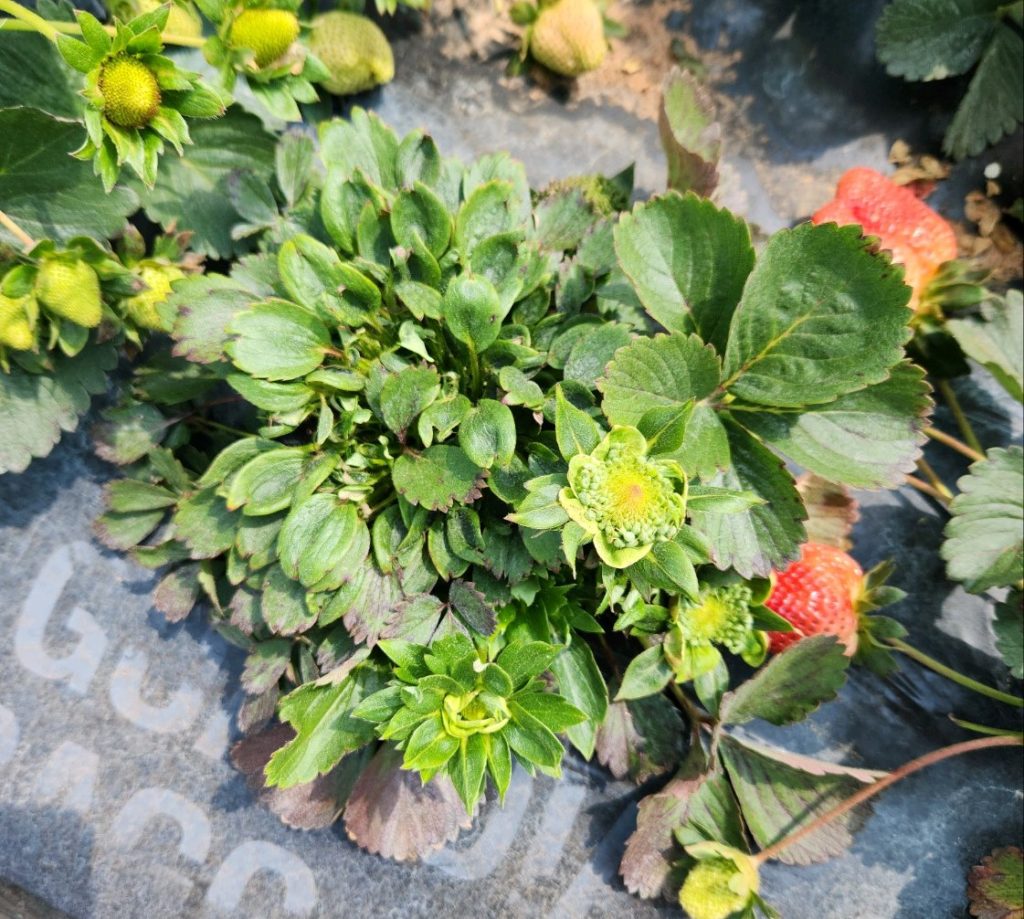Weekly Field Update
Clemson Extension agents provide updates in The South Carolina Grower this week about the status of various crops being produced throughout the state.

Coastal Region
Zack Snipes reports, “I took what seemed like 100,000 calls, emails and texts last week about some odd symptoms on the older leaves of plants. The symptoms included interveinal chlorosis and what looks like a chemical burn or phytotoxicity. I found the symptoms in conventional fields, high tunnels, low tunnels, organic farms, and farms that hadn’t sprayed anything. We are hearing reports from all over the coastal plains and even from the coastal plains in North Carolina. I saw it more on tomato, but potato, pepper, blackberry, watermelon, cowpeas, and winter peas all showed the same symptoms. The good news is that the damage is on the older leaves and the new leaves look great, so I don’t think it will hurt our yields. The regional widespread nature of this phenomenon and the variety of crops where it was found, leads me to believe this was a one-off event that was probably environmental. Ozone damage looks very familiar to what I saw. We are still digging into this, and if we find out what caused it, we will let everyone know. Our strawberries are being picked this week, and I am a little worried about our next flush of berries. Every field that I visited has berries but no flowers. This could mean that we have a few weeks of lull in production.”
Midlands
Rob Last reports, “With all crops at this time of year, it is vital to scout crops regularly. For example, pests and diseases, mites, or diamondback moths can rapidly build up. Both of which are active and present in fields. Scouting crops frequently helps prevent population increases, allows for applying pesticides when numbers reach threshold levels and helps to target the pest at the right developmental stage. The same is true of plant pathogenic diseases. Over the last week, we have seen the population of spider mites increase; diamondback moths are also active. We are seeing evidence of abiotic factors in many crops and fields. The symptoms observed are typically discoloration and desiccation of the oldest leaves, with a window pane effect. (The lesion looks opaque). A wide variety of plant species are being affected. The damage is worst on older leaves, with the new growth looking bright, green, and vigorous. We do not see evidence of haloing, water-soaked lesions, fruiting bodies, or typical “disease” symptoms. However, given the physical injury to the plants and weather conditions conducive to disease development, infection from bacterial and fungal pathogens is a potential risk. Again, it is vital to keep scouting crops early and often to monitor for any changes in the crop. Abiotic factors are often related to weather patterns, so wind damage, UV burning, sun scorch, chill injury, or pollutants such as ozone can all cause similar effects.”

Sarah Scott reports, “Warm daytime temperatures and rain were prevalent across the Ridge last week. Cool night temps are slowing down berry ripening in strawberries, but the crops are looking good. We’ve had some botrytis and Phytophthora pop up, but overall, fields look good. Hoping to have a few days without rain, so water holding in the fields can dry out and improve conditions. Peaches are sizing, and work continues despite having been hit hard by the March freezes. It’s looking as if we’ll have between 30% and 50% of a crop this season, which is amazing considering the freeze events we had. Some areas will be better off, and some worse. There are many microclimates in the area; therefore, some areas have greater exposure while others are more protected. Bacterial issues are showing up in orchards. Trees appear to be late leafing out or holding onto blooms for an extended period. Upon closer observation, you can see twig dieback and some lesions. Cutting into the wood reveals a soured smell. Growers are advised to continue to manage trees even if there is a very short crop. Maintaining the health of the trees for next season is important. Refer to the guide posted a couple weeks ago for a reduced management plan.”
Pee Dee
Bruce McLean reports, “Spring planting is in full swing. Lots of sweet corn, cucumbers, beans, squash, tomatoes, peppers and melons are being planted now. Soil moisture is in good shape in most areas. Growers continue to battle disease in their strawberry fields. Anthracnose and botrytis are still common, and some plant collapse due to anthracnose crown rot can be found. Strawberry growers are still dealing with some lingering cold damage with dead tissue on the tips of the fruit. Anyone seeing this kind of damage should remove these fruit ASAP to reduce the potential for botrytis. Blueberry growers are dealing with lingering cold damaged fruit themselves. Some of the berries are “corky” inside. “Corky” fruit can be a challenge for growers. Unfortunately, that type of damaged fruit tends to persist on the plant, with sizing and coloring similar to undamaged fruit. Come harvest time, some of that fruit will likely find its way into the clamshell or baskets. Packing lines with soft sorters will usually sort out a good portion of this damage.”
Upstate
Andy Rollins reports, “Strawberry production has slowed down greatly. The fluctuation in night temperatures is thought to be the main culprit for this. On some farms, we have found boron and sulfur deficiencies. On others, we have found severe spider mite damage. Cold damage to the tips of green fruit is thought to be causing the extreme increase in split fruit, also called “crab claws” (“chongas” is what many workers call the damaged fruit). Spider mites need to be treated with Acramite, Kanamite, or Nealta to kill multiple life stages. We have cold damage on many other crops but not as serious. The blackberry crop is doing well, as are muscadines.”









